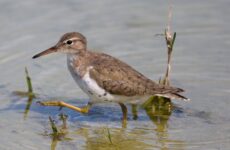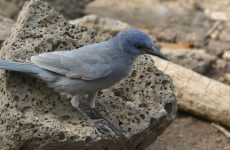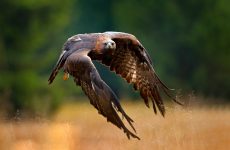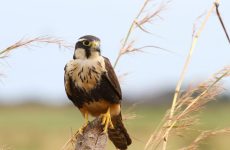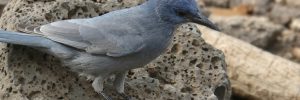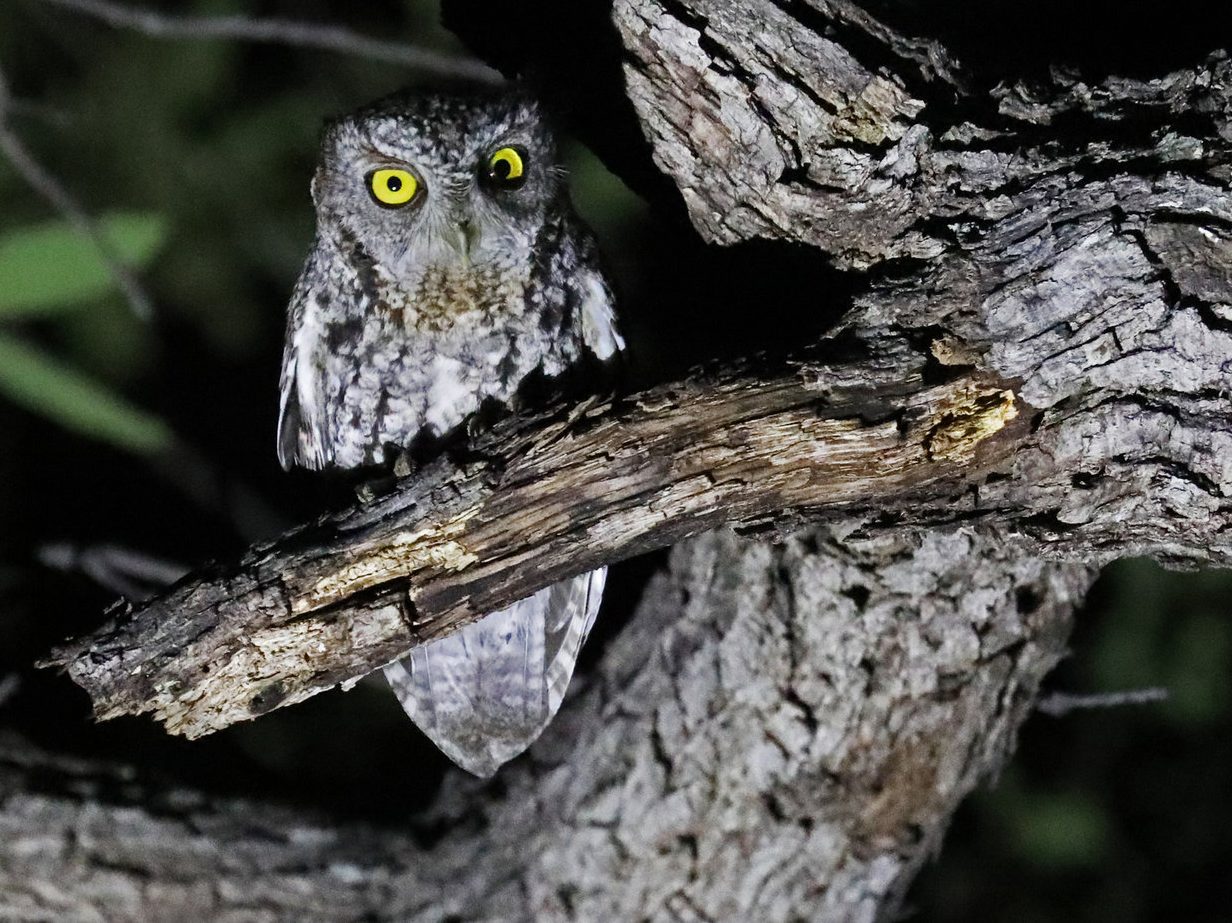
Thirteen of the nineteen owls in North America are found in Arizona. These iconic birds have long held a special place in our hearts, and this guide will help you find out all about them with pictures, their hoots and calls, when to find them, and ID for each of these captivating creatures.
Owls are birds of prey and hunt and eat small mammals as well as snakes, frogs, insects and even other birds.
They eat their prey whole, often after removing the head and sometimes wings, and then regurgitate the bones and fur as a pellet.
The largest Owls in Arizona are the Great Horned Owls, and the smallest owls are Northern Saw-whet Owls.
To find owls in Arizona head to woodlands at dawn or dusk for the best chance of seeing them.
Try looking at high perches on the edge of the forest overlooking open grassland or pastures and listen for their calls.
Twelve of these species of owl in Arizona are regular species and there is also one rare or accidental species.
Although owls look fierce, they are also pretty goofy, especially when you realize how baby owls sleep as their heads are so heavy or what owl legs look like under that fluffy coat.
Owls in Arizona all year: Great Horned Owl, Western Screech-Owl, Whiskered Screech-Owl, Northern Pygmy-Owl, Barn Owl, Spotted Owl, Long-eared Owl, Northern Saw-whet Owl
Owls in Arizona in summer: Burrowing Owl, Elf Owl, Flammulated Owl
Owls in Arizona in winter: Short-eared Owl
Rare or accidental owls in Arizona: Ferruginous Pygmy-Owl
So read on to find out more about the owls of Arizona.
13 Species Of Owl In Arizona
1. Great Horned Owl
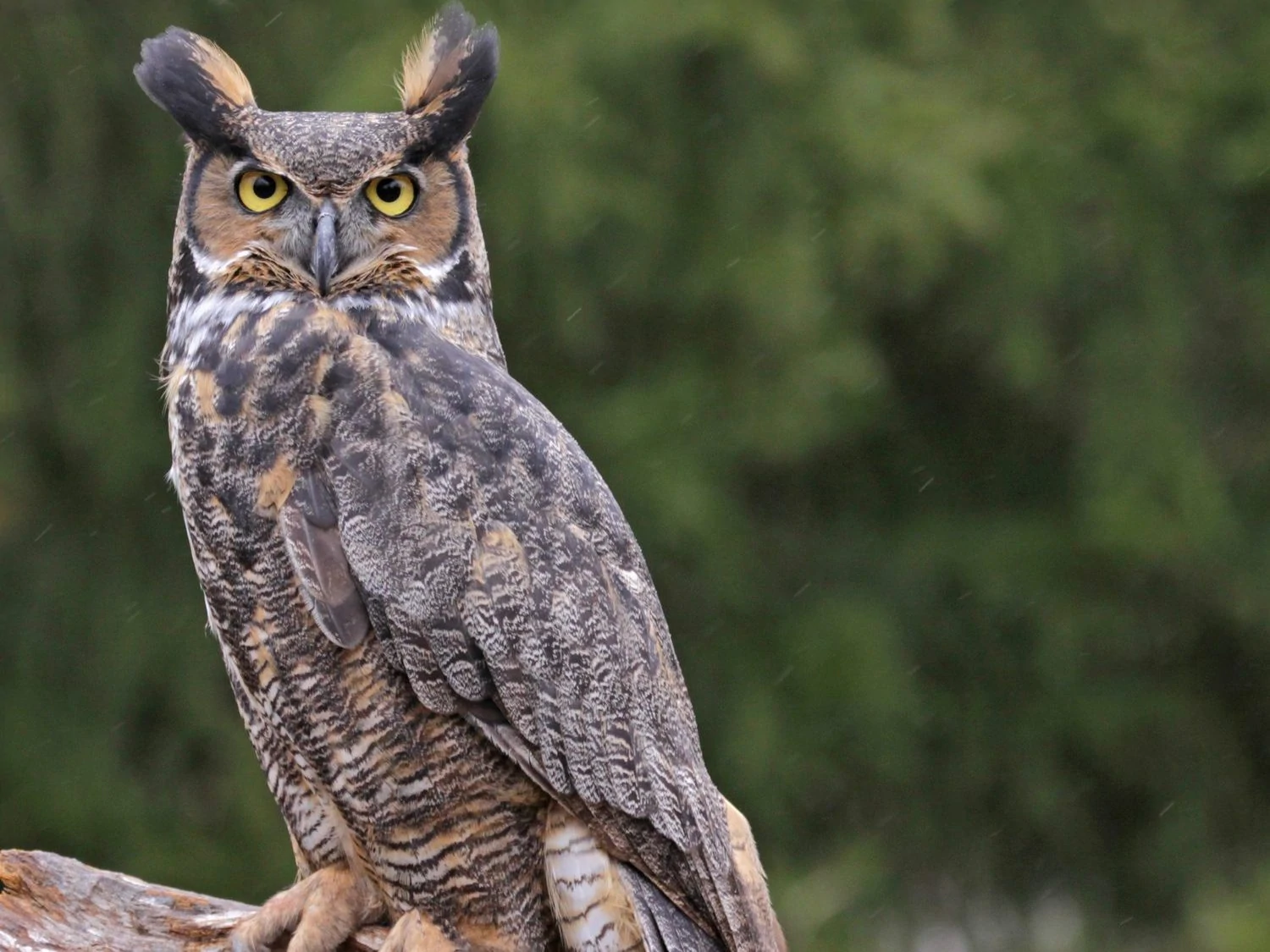
Great Horned Owls are common in Arizona and are residents of the state all year. They are recorded in 2% of summer and winter checklists submitted by bird watchers for the state.
Great Horned Owls are one of the most common owls in North America.
Their most unique physical characteristic is their “Great Horns” which aren’t really horns but ear tufts. They’re tufts of feathers that they use as camouflage to make them appear like branches of trees.
They have grayish to reddish-brown faces, large yellow eyes outlined in black, and their hooked bills are dark gray.
The coloring and patterns of Great Horned Owls are also mainly for camouflage. Their backs and wings are mottled with gray, brown, black, or white. They can be darker or lighter depending on the region they are from and are smaller in the south than in the north.
Juveniles have white, cinnamon, or gray fluffy feathers that make them look “puffed up”. Their barring is less visible, and their ear tufts are smaller and hardly seen.
- Bubo virginianus
- Length: 18.1 – 24.8 in (46 – 63 cm)
- Weight: 32.1 – 88.2 oz (910 – 2500 g)
- Wingspan: 39.8 – 57.1 in (101 – 145 cm)
Great Horned Owls are widespread throughout North America and do not migrate.
You can find Great Horned Owls in almost any environment in North America. As long as they have nesting sites, roosting sites, and an abundance of prey, they will be able to adapt to forests, deserts, grasslands, or cities.
Their varied diet includes small rodents such as mice, skunks, geese, and hares. They will also eat insects, fish, and carrion.
Great Horned also hunt other raptors such as Ospreys, Peregrine falcons, or other owls.
They hunt from a perch, scanning their territory and swooping down to capture their prey with their strong talons. They will also hunt from the ground or wade in the water.
Great Horned Owls: The distinctive 5-note Hoo call of the Great Horned Owl is made by both males and females, but females are higher pitched. They also make various whistles, shrieks, hisses, and coos.
Nests of Great Horned Owls are usually in trees, and they often use an old nest from another species. They line the nest with bark, leaves, downy feathers, or pellets but sometimes leave it unlined. The female lays up to four eggs that are incubated for around a month.
Fun Fact: Great Horned Owls are the crows’ number one enemy. Crows will usually mob Great Horned Owls in their nests, and that is one of the best ways to find them.
2. Western Screech-Owl
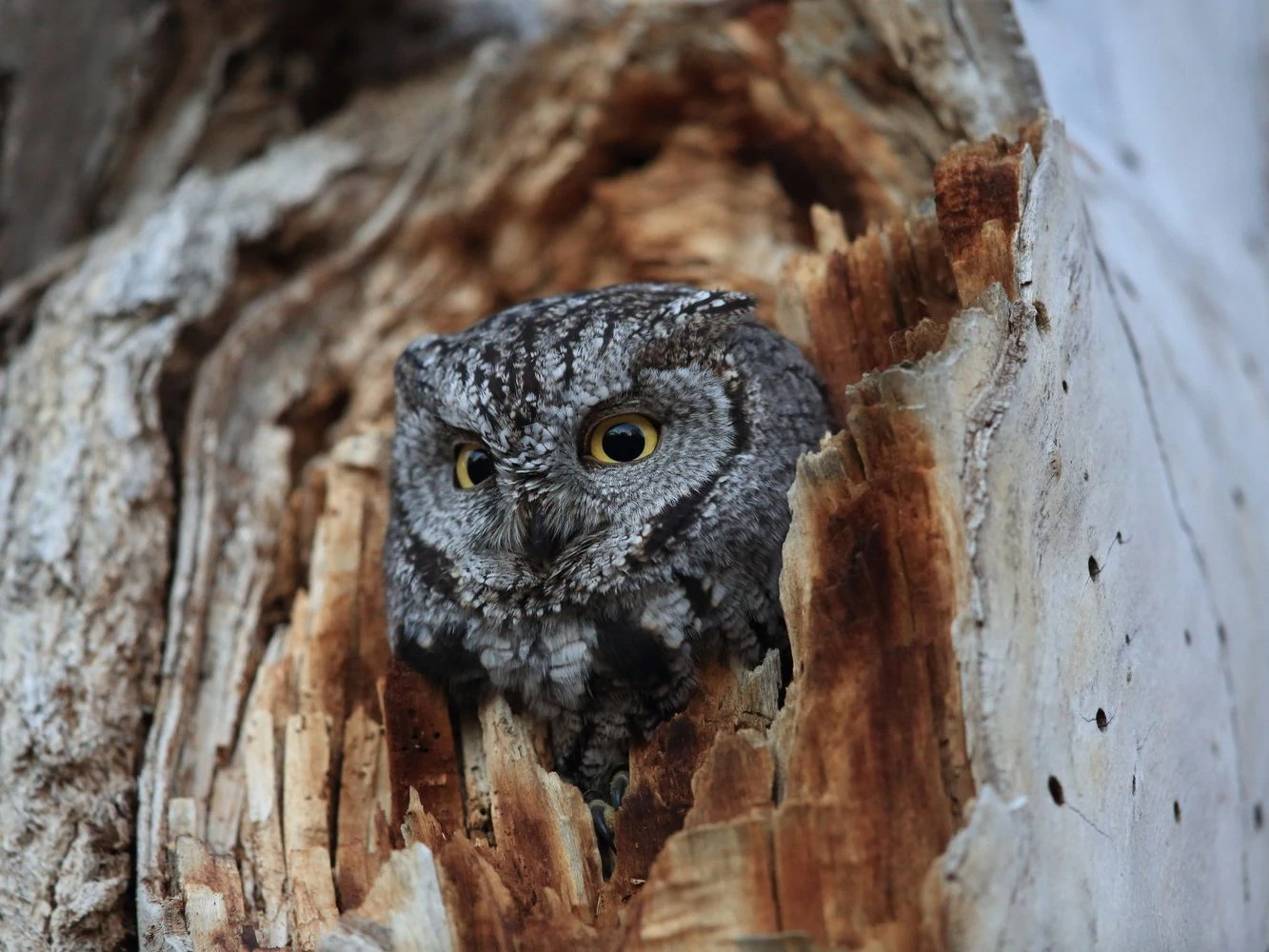
Western Screech-Owls do not migrate and are spotted in Arizona all year but they are spotted more from mid-March to June. They appear in 1% of summer checklists.
Western Screech-Owls are small owls that have squarish heads with dark outlines and visible ear tufts, and they are short-tailed. Their morphs are either gray, brown, or reddish-brown.
They have yellow eyes and yellowish bills. Their upperparts are dotted with white, gray, or brown streaks. Their breasts and bellies are pale with dark, vertical stripes.
Their coloring and pattern enable them to camouflage themselves against the bark of trees.
- Megascops kennicotti
- Length: 7 – 10 in (18 – 25 cm)
- Weight: 5.4 oz (153 g)
- Wingspan: 20 in (51 cm)
Western Screech-owls do not migrate and are resident of western US states, western Canada, and northern Mexico all year.
You can find Western Screech-Owls in environments as high as 6,000 feet. They live in forested areas, open woods with a mixture of pine, oak, and sycamore, and may also be found in the desert, rural fields, and suburban parks and gardens.
Western Screech-Owls are opportunistic feeders and eat small mammals, birds, fish, insects, and even scorpions.
They are wait-and-see predators, taking their time watching from their perch on tree branches and looking out at the ground or water for their prey.
Western Screech-Owls calls: Their distinctive speeding-up hoot sounds like a bouncing ball coming to a stop.
Nests of Western Screech-Owls are usually abandoned nests by woodpeckers or any natural cavities in trees, cliffs, and banks. The female lays two to seven eggs and incubates them for four to five weeks.
When the eggs hatch, the female stays with them for up to three weeks, and then she hunts with the male.
Fun Fact: While roosting during the day, Western Screech-Owls try to blend in with their surroundings, so they press themselves against the tree to be camouflaged against it.
3. Burrowing Owl
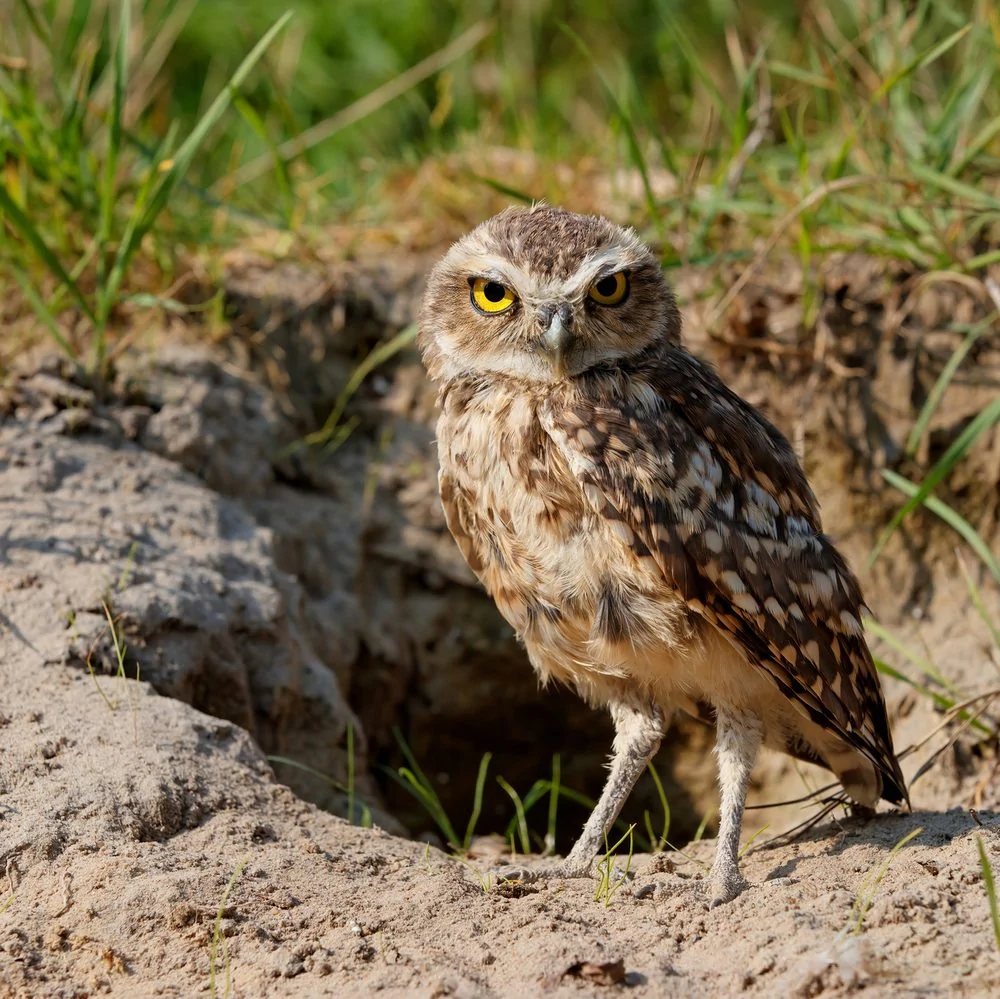
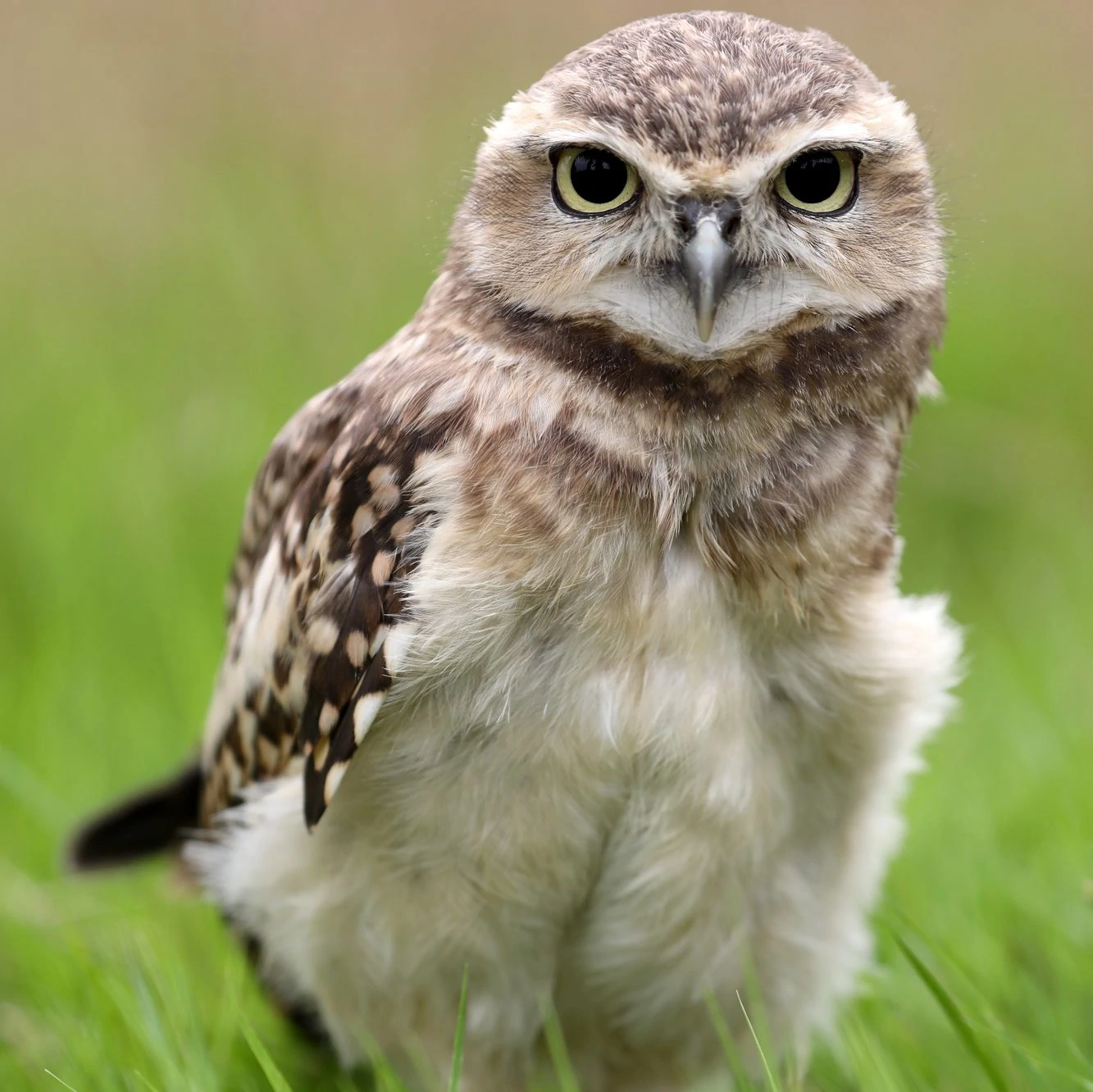
Burrowing Owls spend the breeding season in Arizona, mainly in the north of the state, but some hang around all year in the south of the state.
Burrowing Owls are small, long-legged owls that typically lives in prairie dog burrows (hence its name).
Adult Burrowing Owls generally have brown feathers with numerous white spots and no ear tufts.
They have yellow eyes and bills and a white patch on their chins which becomes visible when they bob their heads or when they become agitated.
Juveniles are also generally brown, they have no white spots on their heads, and they have plain white bellies.
- Athene cunicularia
- Length: 9 – 11 in (23 – 28 cm)
- Weight: 5.3 oz (150 g)
- Wingspan: 20 – 24 in (51 – 61 cm)
Burrowing Owls breed in western US states and migrate south to Mexico for winter. Those in southwestern US states and Florida remain all year.
You can find Burrowing Owls in deserts and open grasslands, prairies, and agricultural areas. Rather than looking for them in trees, look for them hunting on the ground, nesting in underground dens, and perching on fence posts.
Burrowing owls hunt both day and night.
They rest in their burrows in between hunting. They sit and wait from their perch and then silently glide to their prey. They catch mice, small rabbits, rats, gophers, bats, lizards, and small birds.
They can run and fly low when hunting on land, but they can also wade through shallow water to catch other animals.
Burrowing Owls calls: They are relatively quiet owls. Males make a coo call, and the young are able to mimic a rattlesnake rasp.
Nests of Burrowing Owls are old, underground holes dug by prairie dogs, badgers, and other burrowing animals. Florida Burrowing Owls dig their own burrows, and Cape Coral has at least 1,000 nesting pairs. They may also use old pipes or nest boxes.
The female lays seven to twelve eggs which she incubates for three to four weeks. The male supports her by bringing food. When the eggs hatch, both parents feed their young and will continue to do so until they’re about three months.
Fun Fact: Burrowing Owls use animal dung or manure to attract insects to the burrow and control the microclimate! The dung or manure that is often used in nest building was originally thought to mask the scent of juvenile owls.
4. Elf Owl
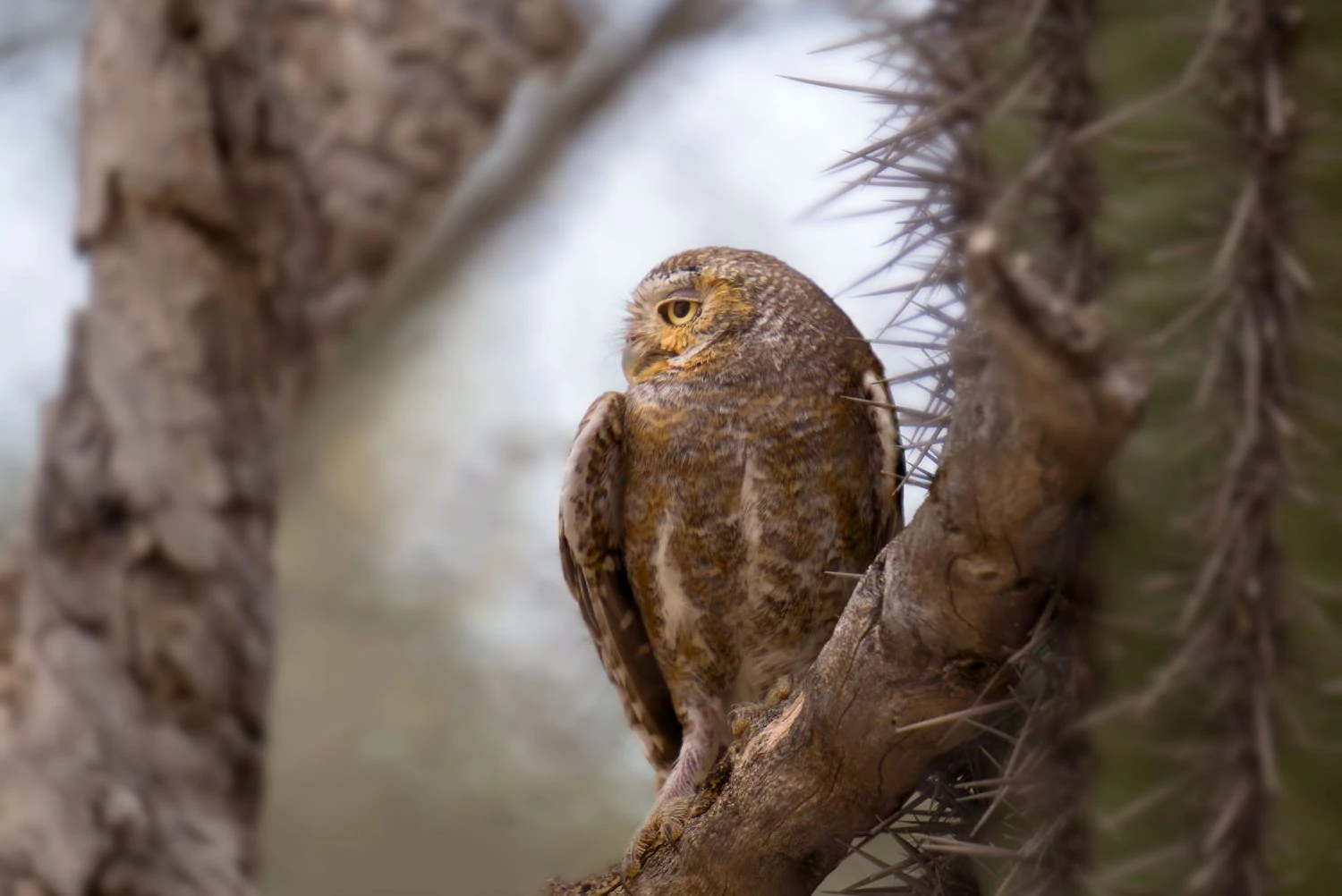
Elf Owls breed in southern Arizona and occur in 1% of summer checklists. They arrive in mid-February and start to migrate in August.
Elf Owls are tiny desert owls that are team players that will band together to deter predators.
They are usually brown and spotted with gray, cinnamon, brown, and white, and they don’t have any ear tufts, so their heads appear round and big.
The Elf Owl is the world’s smallest owl.
They have pale yellow eyes bordered with thin, white eyebrows and short tails. Juveniles are grayer than adults but otherwise the same.
- Micrathene whitneyi
- Length: 5 – 6 in (13 – 15 cm)
- Weight: ¼ oz (40 g)
- Wingspan: 15 in (38 cm)
Elf Owls breed in southwestern US states and northern Mexico before migrating further south for winter.
You can find Elf Owls primarily in deserts with plenty of giant saguaros or tree-like cacti that grow to over 12 meters tall. Aside from desert environments, they also inhabit thorn scrubs and woodlands near the banks of rivers or lakes with mesquite and other similar trees.
Elf owls are nocturnal by nature, so they do their hunting at night. They have incredible vision and hearing, which allow them to catch insects in mid-air, pluck them from vegetation, like moths and insects that are found in agaves and ocotillos, and they also chase their prey, such as lizards on foot.
They can even eat scorpions, but they remove their stingers before they swallow them.
Elf Owl calls: They make several calls, either softer when nesting or sharp in alarm. Males also sing a yapping-sounding series of notes.
Nests of Elf owls are in abandoned woodpecker holes in trees, in giant cacti, or in nest boxes and just leave it bare.
The female lays up to five eggs and incubates them from fourteen to twenty-four days. It’s the male’s responsibility to keep his family fed while the female takes care of the young.
Attracting Elf Owls to your backyard is possible if your house is within their range. Place the nest box high enough (72-120 inches) and face it north or northwest.
Fun Fact: Elf Owls practice “mobbing” or grouping together with other Elf Owls to overwhelm predators like snakes, mammals, and other larger owls.
5. Whiskered Screech-Owl

Whiskered Screech-Owls do not migrate and are residents of Arizona all year but they are only spotted around the southeast of the state.
Whiskered Screech-Owls are small owls that have rounded heads and short ear tufts. They have large, yellow eyes and long whiskers at the base of their grayish-yellow hooked bill. Their legs and feet are feathered.
The Whiskered Screech-Owl is often mistaken for the Western Screech-Owl because they look very similar. However, the Whiskered Screech-Owl is smaller in size and has thicker vertical stripes on its belly.
They have dark-gray and reddish-brown morphs.
- Megascops trichopsis
- Length: 6.5 – 8 in (17 – 20 cm)
- Weight: 3 oz (85 g)
- Wingspan: 17.5 in (44 cm)
Whiskered Screech-Owls do not migrate and are resident all year in Mexico and across the border into southwestern US states.
You can find Whiskered Screech-Owls in dense pine-oak woodlands at 5,249 feet (1,600 meters) elevation. They also inhabit canyons with groves of sycamores which may be near oak woodlands. You may see them with Western Screech-Owls when they go to lower elevations during winter.
Whiskered Screech-Owls usually forage between branches of trees for insects, like grasshoppers, praying mantises, crickets, beetles, moths, and caterpillars. They will also hunt their prey from their perch or capture them in flight.
Whiskered Screech-Owl calls: They make a long series of fast hoots.
Nests of Whiskered Screech-Owls are often in abandoned woodpecker holes, empty tree cavities, or holes in cacti.
They may also stay in nest boxes with the appropriate entrance and about 10 to 30 feet above the ground.
The female lays around two to four eggs and incubates them by herself. During this time, the male supports her by feeding her and defending their territory. Once the eggs hatch, the female will also join in the hunt for food.
Fun Fact: The Whiskered Screech-Owl is also called the Arizona Whiskered Owl, Spottech Screech-Owl, and Whiskered Owl. Its whiskers define it because they’re longer and denser than any other owl.
6. Northern Pygmy-Owl
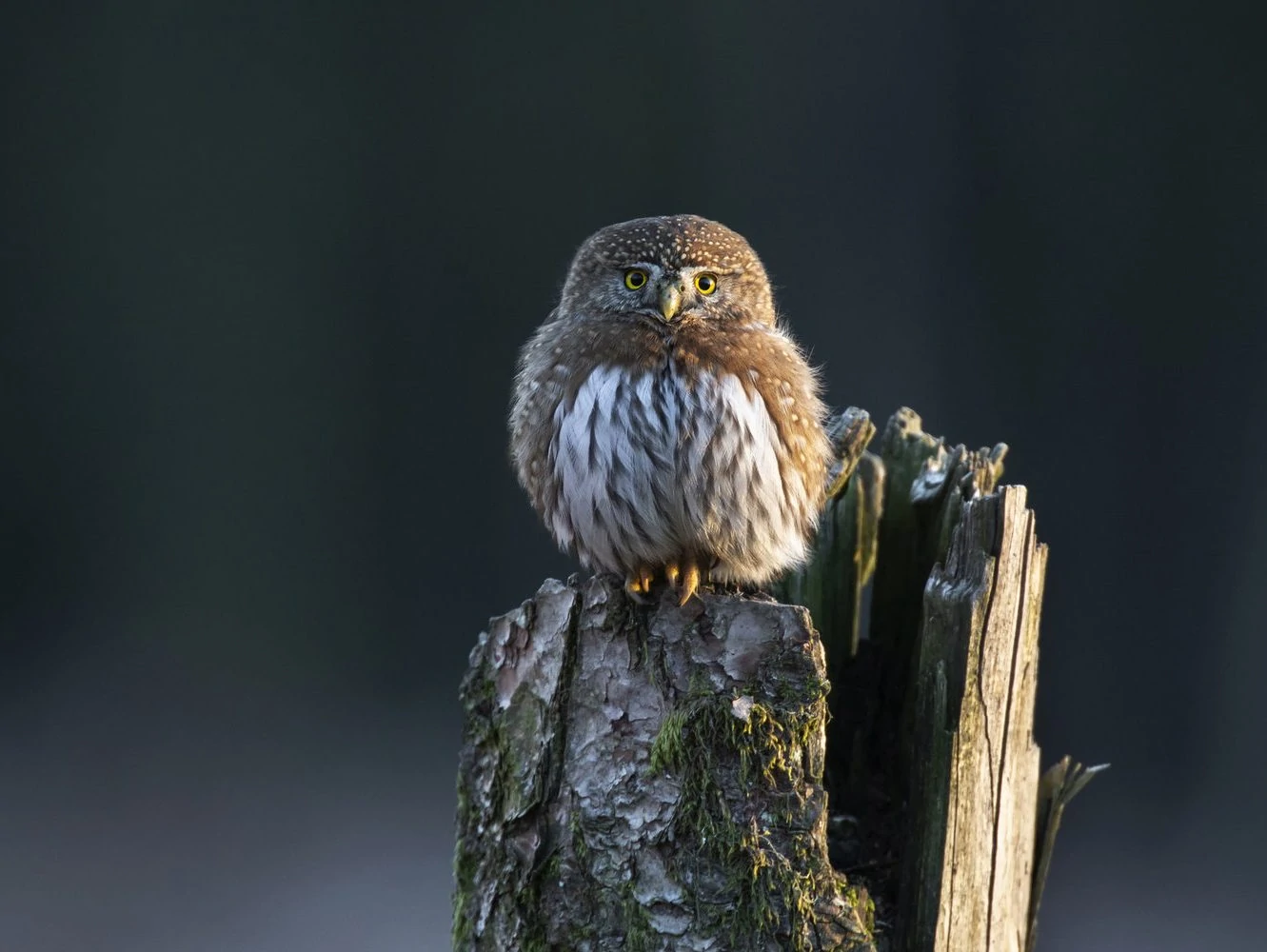
Northern Pygmy-Owls are residents of Arizona all year.
Northern Pygmy-Owls are small and compact, with large round brown heads. Their eyes are yellow, as are their bills. Their backs, wings, and breasts all have white spots on brown feathers, but their bellies are white with dark brown vertical stripes.
One unique feature of Northern Pygmy-Owls is that they have white-bordered black spots at the back of their heads that kind of look like an extra pair of eyes. There are also red morphs and gray morphs.
- Glaucidium californicum
- Length: 7 – 7.5 in (18 – 19 cm)
- Weight: 2/2 oz (62 g)
- Wingspan: 12 in (30 cm)
Northern Pygmy-Owls do not migrate and are resident in western regions from British Columbia down to Mexico.
You can find Northern Pygmy-Owls mostly in forests along streams with fir, spruce, cottonwood, aspen, and other mixed trees.
During winter, it’s possible that Northern Pygmy-Owls may be seen in towns and backyards, hunting songbirds flocking at bird feeders.
Northern Pygmy-Owls are active hunters during the day, adapting a “wait and see” strategy when choosing and tracking their prey.
They feed on small mammals, birds like hummingbirds, chickadees, warblers, and sparrows, and insects like beetles, butterflies, crickets, and dragonflies, which they can sometimes catch in mid-flight.
Northern Pygmy-Owls calls: A series of high ‘toots’.
Nests of Northern Pygmy-Owls are often the abandoned nests of woodpeckers or empty cavities in trees. The female lays up to seven eggs and incubates them for about a month. The male takes care of feeding the female and the chicks once they hatch.
7. Barn Owl
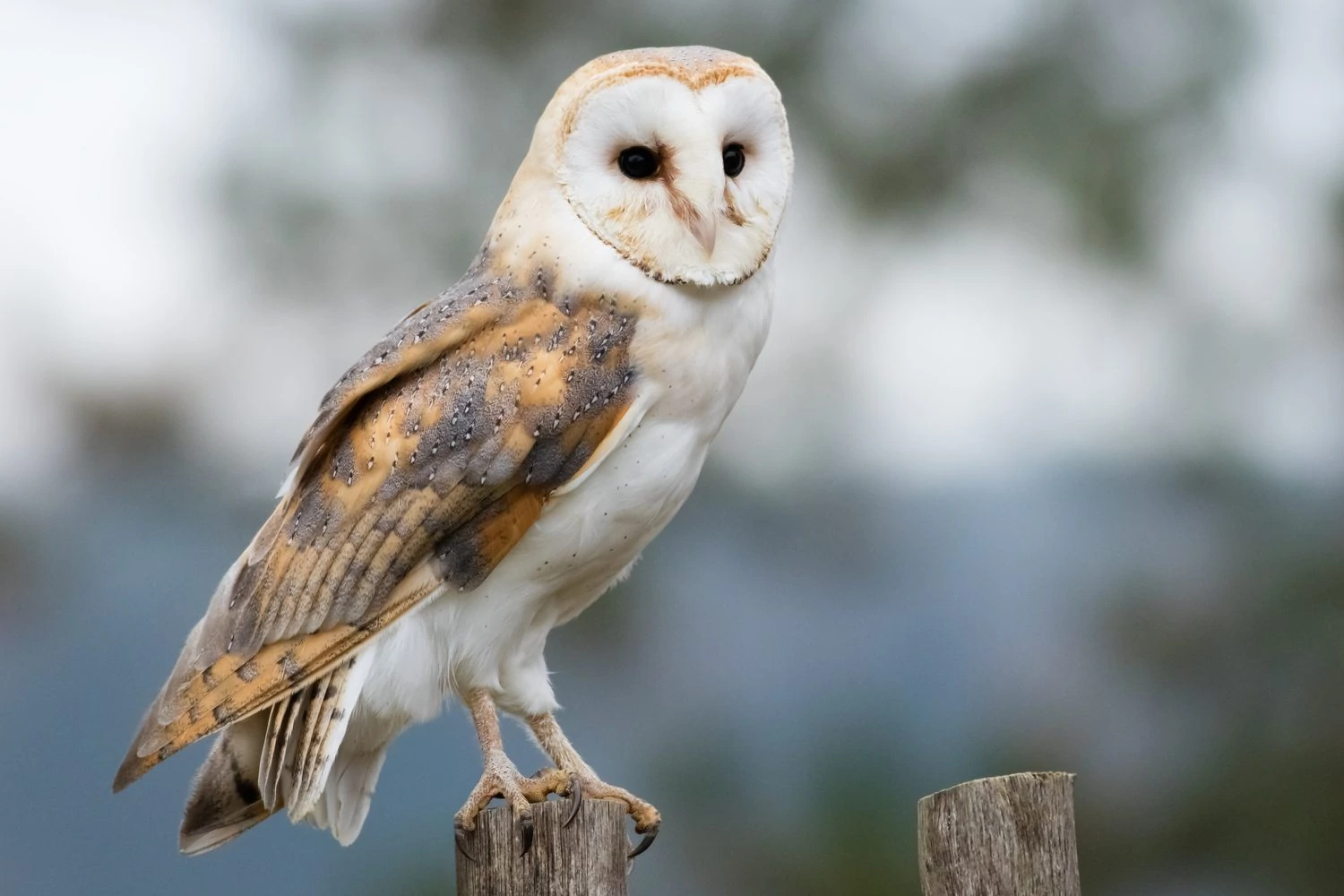
Barn Owls do not migrate and can be spotted in Arizona all year.
Barn Owls are the most widespread land birds in the world, with as many as thirty-five subspecies and they are found on all continents except Antarctica and the Saharan desert.
Barn Owls’ white heart-shaped faces and contrasting dark eyes make them one of the most beloved owls.
Their chests, bellies, and underwings are also white with varying amounts of spots. Their upperparts are a combination of gray, brown, and red colors, with some being lighter or darker than others. They have long rounded wings, short tails, and long legs.
- Tyto furcata
- Length: 12.6 – 15.8 in (32 – 40 cm)
- Weight: 14.1 – 24.7 oz (400 – 700 g)
- Wingspan: 39.4 – 49.2 in (100 – 125 cm)
Barn Owls do not migrate and can be found in most US states and just across the northwestern border into Canada.
You can find Barn Owls in largely open habitats, edges of forests, agricultural fields and farmlands, suburbs, and cities.
During the day, make sure to look in hollow logs and cavities in trees and in barns (hence their name) where they roost.
Barn Owls predominantly find prey by sound as they have the best hearing of any animal tested. This helps them to catch prey in complete darkness or those hidden under vegetation or snow.
Their usual prey includes small mammals like rats, voles, bats, rabbits, and lemmings. They will also hunt and kill small birds, lizards, and insects.
They swallow their prey whole and cough up pellets containing bones and fur twice a day.
Barn Owl Calls: They don’t hoot, but make a harsh screech.
Nests of Barn Owls are usually in tree cavities or caves and often in barns or other abandoned or quiet buildings. They lay up to eighteen white eggs and up to three broods. The incubation takes around a month.
The nest is made of regurgitated pellets arranged into a cup with their feet.
Fun Facts: Females have spots on their chests that have been shown to reduce parasites, and so the more spots the female has, the more a male helps build the nest!
8. Spotted Owl
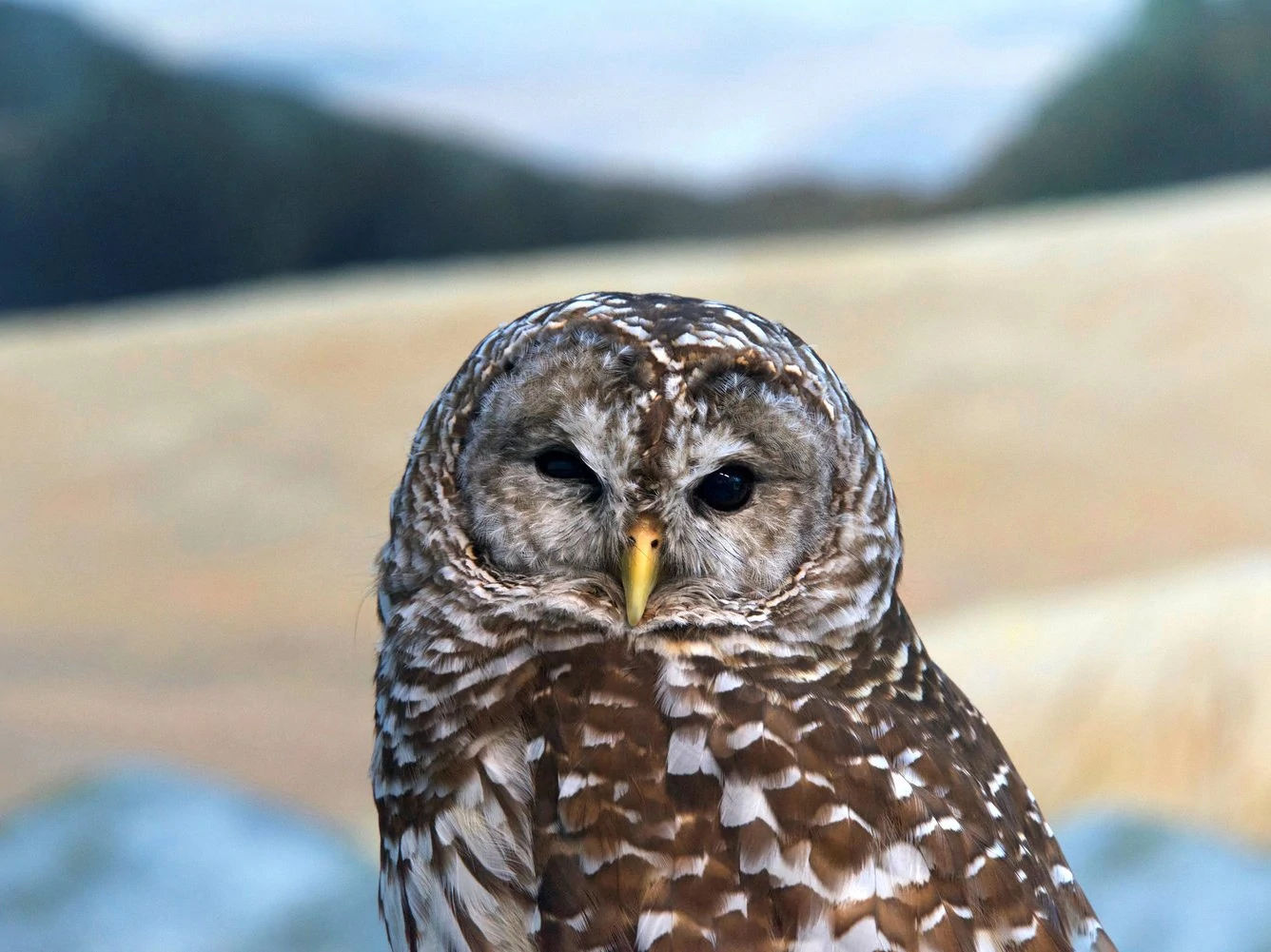
Spotted Owls are near-threatened species in Arizona and are residents of the state all year.
Spotted Owls are medium-sized and dark brown with white spots. The further south the species, the paler their coloring and the larger their white spots become.
Its facial disk is quite defined with a dark border. It has white eyebrows and whiskers, dark eyes, and a hooked yellow bill. Its back and wings are dark-brown with white spots. Its belly is dark-brown with white horizontal lines or bars.
There are three subspecies in North America, the Northern Spotted Owl, California Spotted Owl, and Mexican Spotted Owl. They differ slightly in how dark they are and the size of their spots.
- Strix Occidentalis
- Length: 16 – 19 in (41 – 48 cm)
- Weight: 20.8 oz (589 g)
- Wingspan: 40 in (102 cm)
Spotted Owls do not migrate and are resident all year along the Pacific Coast and southwestern US states.
You can find Spotted Owls in old, mature, dense forests with a lot of canopy cover. It prefers environments with old, large trees, which is why it’s considered a “Near Threatened” species due to habitat loss from timber logging.
Spotted owls mostly feed on small to medium-sized prey such as flying squirrels and dusky-footed woodrats. Other prey includes mice, red tree voles, snowshoe hares, gophers, and bats. They may also target small owls, birds, amphibians, and insects.
Spotted Owl Calls: As they are a threatened species, the calls of Spotted Owls are restricted to help prevent their decline. However, they do make hoot, like many owls.
Nests of Spotted Owls are mostly in abandoned nests or cavities in trees. They make sure that a dense cover from the treetops protects the nest and the young.
While the male selects the nesting site, the female makes it her own by adding a few feathers or materials to the nest. She will lay up to four eggs which incubate for about a month.
The male will tend to her, bringing her food while she incubates their young.
Fun Fact: The spotted owl looks similar to the barred owl, but the spotted owl has horizontal lines and the barred owl has vertical streaks.
9. Flammulated Owl
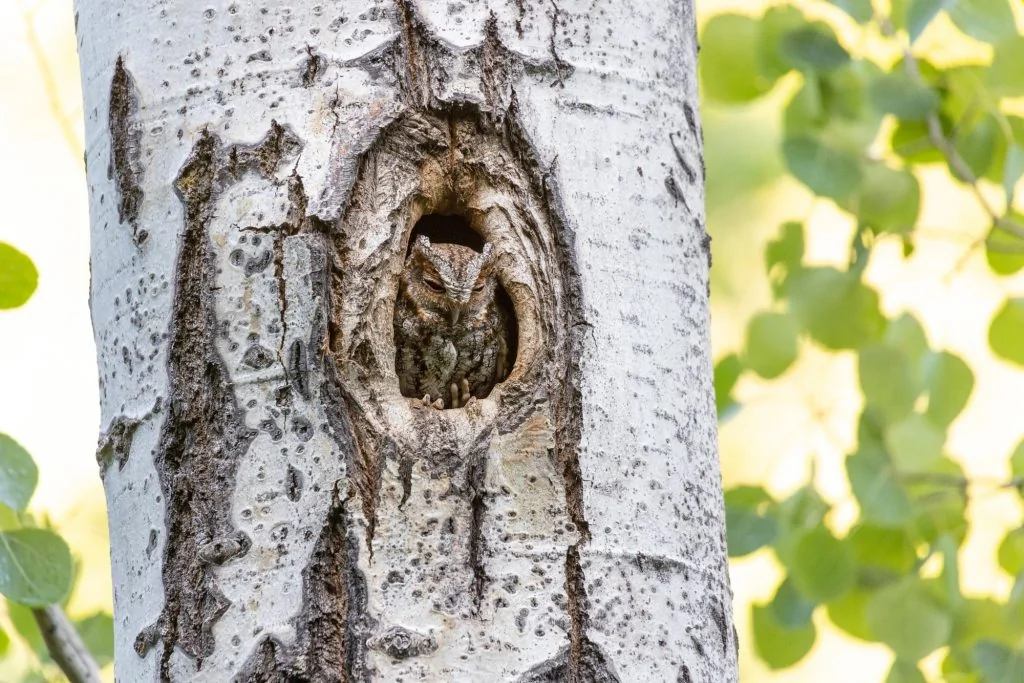
Flammulated Owls spend the breeding season in Arizona and are spotted here from mid-March to October.
Flammulated Owls are small owls that are either gray or rufous and are well-camouflaged against the trees.
Their heads have a rectangular shape, and they are the only small owls that have dark eyes (the others have yellow eyes). The reddish-brown coloring on their facial disk contrasts against the white eyebrows and dark eyes.
- Psiloscops flammeolus
- Length: 6 – 7 in (15 – 18 cm)
- Weight: 1.9 oz (54 g)
- Wingspan: 13 in (33 cm)
Flammulated Owls breed in western US states, southwestern Canada, and northern Mexico before migrating further south for winter.
You can find Flammulated Owls in forests. They prefer habitats with open, mature trees, especially when there’s an abundance of natural nesting holes.
An unusual trait of Flammulated Owls is that they eat mostly insects, not mammals, particularly moths, crickets, grasshoppers, bugs, and beetles.
Since their preferred habitat is in high treetops, they forage for insects among the trees’ foliage or in the lower shrubs. They may occasionally eat small rodents, which they snatch from the ground.
Flammulated Owls calls: They make a variety of calls, peeps, hisses, and screams. Males also make a low hoot.
Nests of Flammulated Owls are almost always abandoned woodpecker holes. If no woodpecker holes are found, any natural tree cavity will do. They also use nest boxes which are intended to replace the fast-disappearing natural cavities in trees.
Flammulated Owls are monogamous, having one mate for many consecutive breeding seasons.
They also use their previous nest territories. The female lays two to three eggs that take about twenty-three days to hatch. The male cares for the female and brings her food. When the eggs hatch, their parents will still take care of the young owls until they’re five weeks old.
Fun Fact: The Flammulated Owl gets its name from the Latin word “flammeolus” meaning flame-colored or with flame-like markings.
10. Long-eared Owl
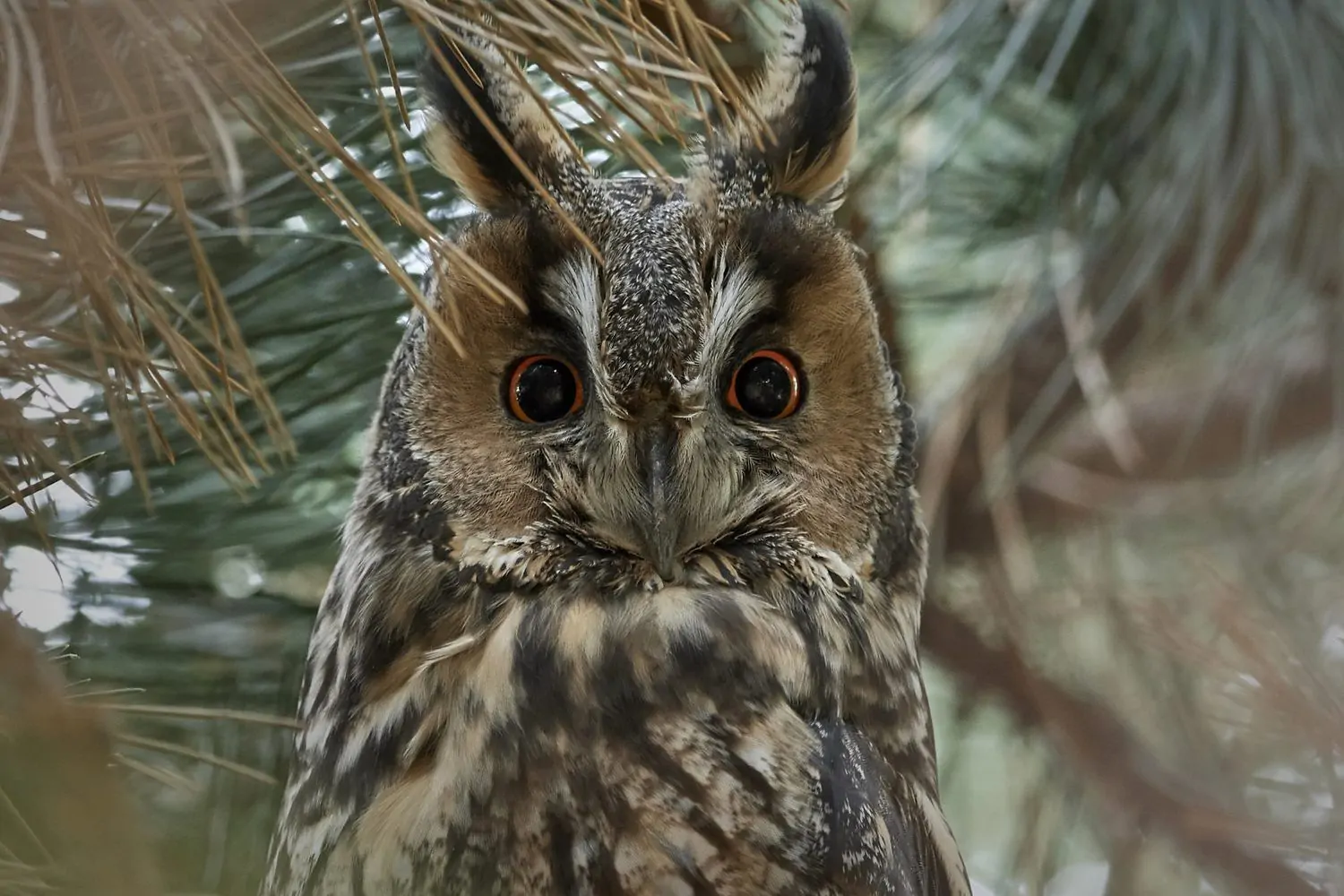
Long-eared Owls breed in the north and west of Arizona and they are spotted during migration in the south of the state. However, some also stay during winter.
Long-eared Owls are slender, medium-sized owls known for their obvious ear tufts, hence their name. They look similar to Great Horned Owls but are much smaller, and the ear tufts are closer together.
They have a surprised expression due to their facial disc and mustache-like feathers around their bill.
Their upperparts are mottled gray, brown, white, and buff. Their underparts have a unique cross-barred pattern of varying orange, brown, black, and white. Their tails are white with dark brown barring.
They are darker in eastern US states and lighter in the west.
- Asio otus
- Length: 13.8 – 15.8 in (35 – 40 cm)
- Weight: 7.8 – 15.3 oz (220 – 435 g)
- Wingspan: 35.4 – 39.4 in (90 – 100 cm)
Long-eared Owls breed in Canada and northern US states and migrate to the rest of the US and Mexico for winter. However, some remain resident all year, especially in inland western US states.
You can find Long-eared Owls in wooded areas with dense coniferous or deciduous trees for roosting and near open grasslands for hunting. The thick foliage of these trees helps camouflage them from potential predators.
Small mammals such as voles, mice, young rats, and rabbits are the main prey of Long-eared Owls, but they may also eat small birds
They fly just a few feet off the ground, listening for movement of prey.
Long-eared Owls calls: They are relatively silent owls but make slow, steady ‘whoo’ calls during the breeding season.
Nests of Long-eared Owls are often stick nests abandoned by other species, or they use tree cavities or hollows.
The female lays up to ten eggs and incubates them for about four weeks. It takes around three weeks for the chicks to start “branching” out even though their parents will still feed them at this point.
Fun Fact: Long-eared Owls are rarely heard except during breeding time. They make soft low hoots and whistles, whines, shrieks, and cat-like meows.
11. Northern Saw-whet Owl
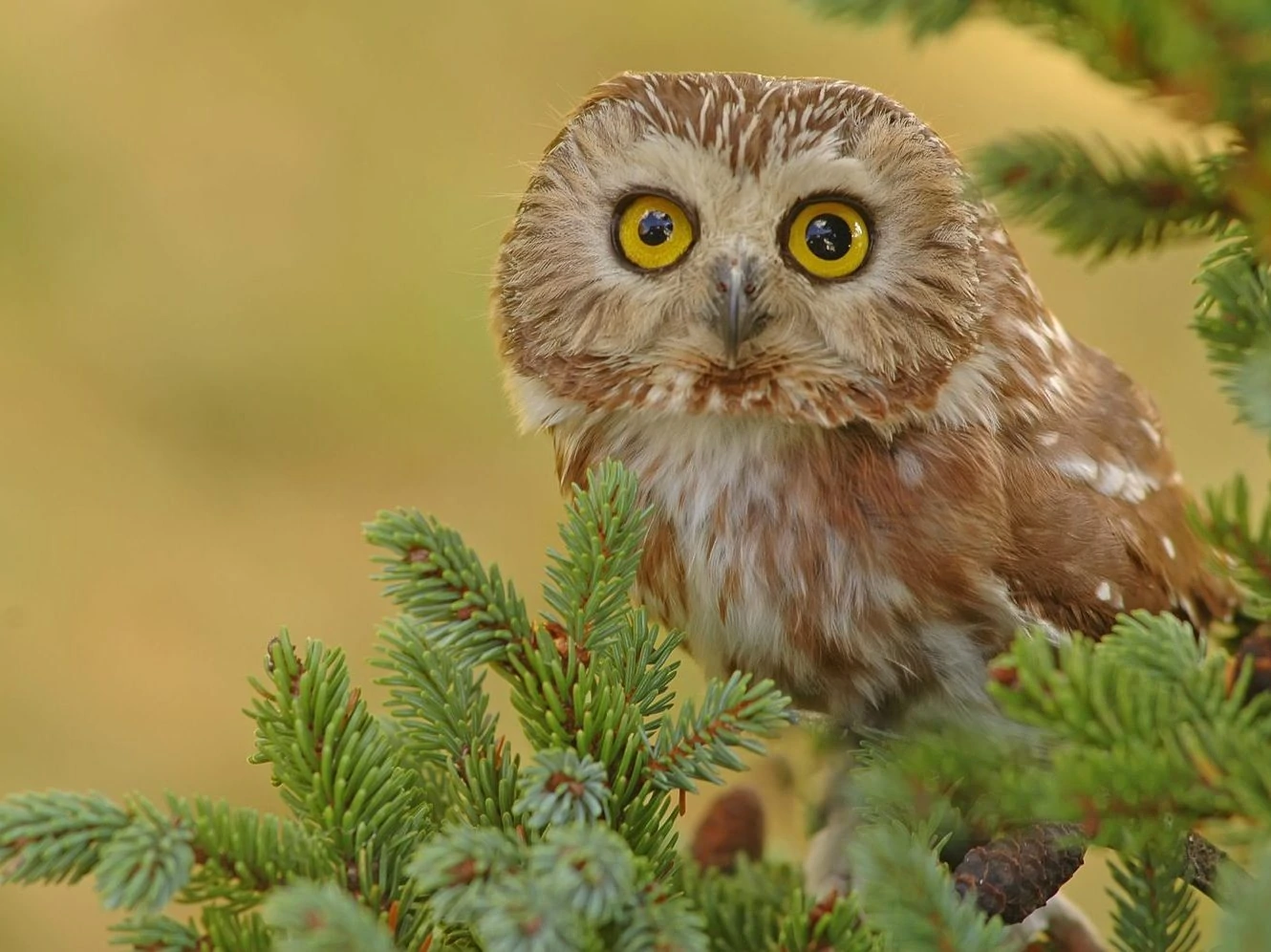
Northern Saw-whet Owls spend the breeding season in Arizona and some are spotted during spring migration in the northeast and southeast of the state. You might even spot a few during winter around Prescott.
Northern Saw-whet Owls are one of the smallest owls in North America, with them being about the size of a robin.
They have tiny brown bodies but large round heads with fine white streaks. Their eyes are bright yellow with thick white feathers forming a “Y” in between them.
Their backs and wings are brown with white spots. Their chests and bellies are white with brown streaks.
Juveniles have plain brown heads and very visible white eyebrows on brown facial discs. Their underparts are plain cinnamon brown, and they also have no spots on their backs.
- Aegolius acadicus
- Length: 7.1 – 8.3 in (18 – 21 cm)
- Weight: 2.3 – 5.3 oz (65 – 151 g)
- Wingspan: 16.5 – 18.9 in (42 – 48 cm)
Northern Saw-whet Owls are usually resident all year in Canada, northern US states, and western US states. However, they may migrate to lower areas in winter to the rest of the US.
You can find Northern Saw-whet Owls in dense coniferous forests where they roost hidden among the thick branches and foliage. However, they like it near an open area and water source where they hunt.
They are nocturnal, so they hunt mostly mice from a perch at night. They may also eat voles, bats, chipmunks, and squirrels.
Northern Saw-whet Owls calls: A long series of urgent hoo calls.
Nests of Northern Saw-whet Owls are tree cavities that have been left from other species, such as Pileated Woodpeckers. They do not add any other nesting material and instead lay their eggs directly on the debris.
The female lays four to seven eggs that take four weeks to incubate. The male’s job is to bring the female food while she’s incubating.
Attracting Northern Saw-whet Owls to your backyard is possible with a nest box if you are in range and have lots of trees.
Fun Fact: The Northern Saw-whet Owl got its name from its repeated tooting whistle, or the “skiew” sound that it makes when it’s alarmed or threatened. The sound is similar to the whetting of a saw.
12. Ferruginous Pygmy-Owl

Ferruginous Pygmy-Owls are considered rare or accidental species in Arizona but they do not migrate and are residents here all year. However, they have only been spotted around the south of the state, around Tucson and Sasabe.
Ferruginous Pygmy-owls typically have brown backs and wings with a few white spots. Their heads are lighter in color with white streaks, and they don’t have any ear tufts.
Their eyes are lemon-yellow, like their hooked bills.
One unique physical feature of the Ferruginous Pygmy-owl is the marking on its nape that resemble eyes. They have two black patches outlined in white on their napes that birders fondly call “false eyes”. They are thought to confuse predators and smaller prey.
- Glaucidium brasilianum
- Length: 6.5 – 7 in (17 – 18 cm)
- Weight: 2.2 oz (62 g)
- Wingspan: 15 in (38 cm)
Ferruginous Pygmy-owl are resident all year from South America up to Mexico and into southwestern US states along the border.
You can find the Ferruginous Pygmy-owl on wooded riverbanks in the desert. They prefer habitats with mesquite, live oak trees, and saguaro cacti.
They hunt during the day but are considered crepuscular (active during twilight). They sit and wait at their perch and then swoop in for a quick strike. Usually, they capture insects, birds, rodents, and lizards.
Ferruginous Pygmy-owls calls:
Nests of Ferruginous Pygmy-owls are usually in tree cavities like abandoned woodpecker holes. In the absence of woodpecker holes, any natural hole that is roughly ten to thirty feet above ground will do.
The female lays three to four eggs and incubates them for four weeks. While she’s incubating, the male regularly feeds her. When the eggs hatch, the male will continue to find food to feed both the female and their young.
Fun Facts: The Ferruginous Pygmy-owl may be small in size but is considered a dangerous predator because of its oversized feet and talons that allow it to attack animals much larger than itself.
13. Short-eared Owl
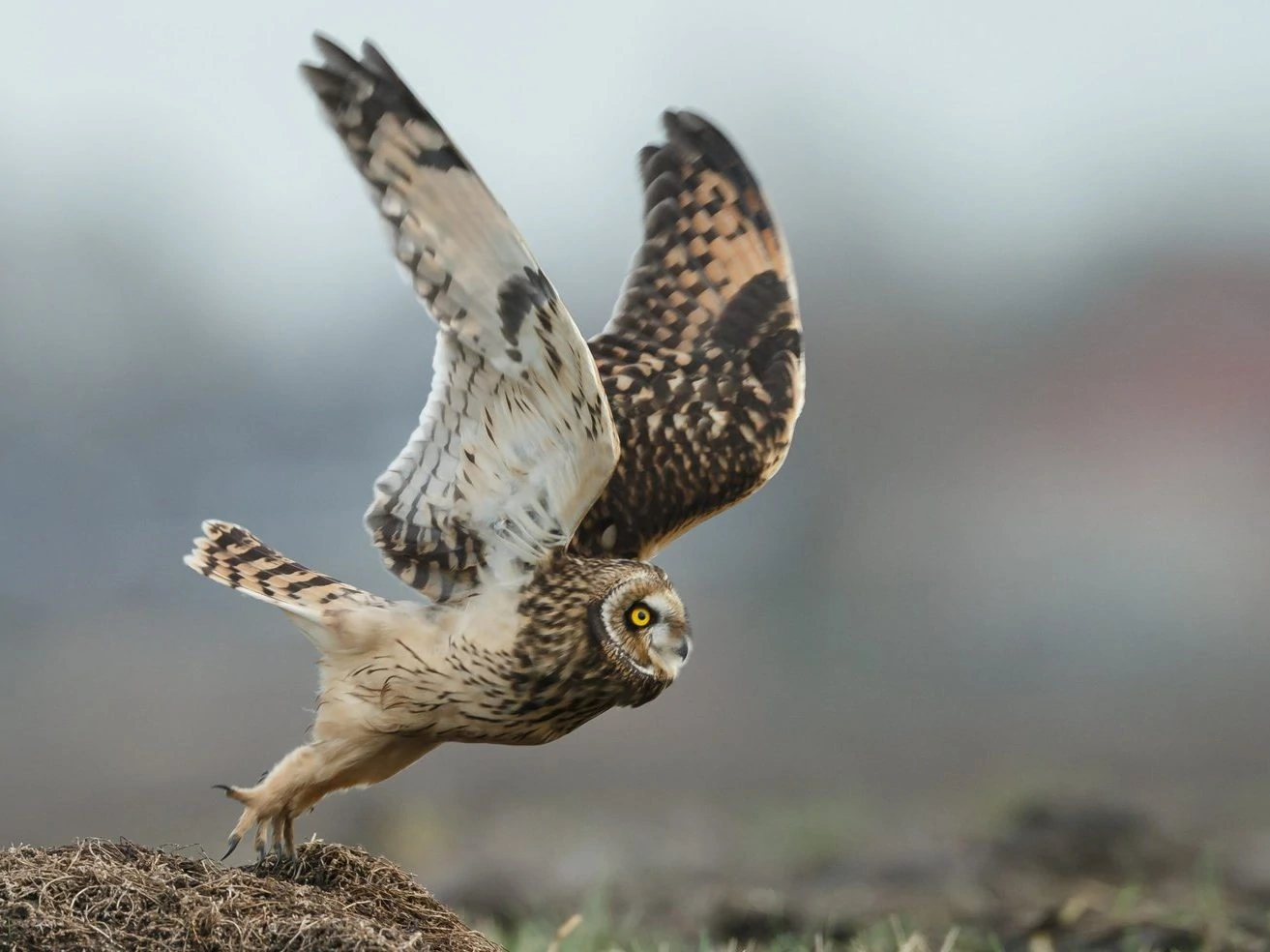
Short-eared Owls are not often spotted in Arizona but some spend winter in the state from October to March.
Short-eared Owls are aptly named because they do have short ear tufts, hardly visible except when in a defensive pose.
They are medium-sized, with a large, round, pale facial disk bordered in white. Their eyes are yellow and outlined in black. Their bills are short, hooked, and black.
Their backs and wings are light and dark brown and white mottling. The upper breast is heavily streaked with dark brown, but the chests and bellies are pale or buffy. Their tails are also barred with dark brown.
- Asio flammeus
- Length: 13.4 – 16.9 in (34 – 43 cm)
- Weight: 7.3 – 16.8 oz (206 – 475 g)
- Wingspan: 33.5 – 40.5 in (85 – 103 cm)
Short-eared owls that breed in Canada and Alaska usually migrate to the US for winter, but many remain all year in northern US states.
You can find Short-eared Owls everywhere in the world except for Antarctica and Australia. They particularly like uninhabited areas since they nest and roost on the ground, such as open prairies, coastal grasslands, tundra, marshes, and dunes.
Unlike most owls, Short-eared Owls hunt during the day, mostly at dawn and dusk, timing their hunt when voles are especially active.
They fly low over the ground looking and listening for movement from their prey of small mammals such as voles and mice.
They also eat birds like gulls and shorebirds, and usually take off the wings of the birds before they eat them.
Short-eared Owls calls: They are relatively quiet, but they make a series of continuous hoots and also scream, bark and whine.
Nests of Short-eared Owls are built by scraping the ground into a bowl and lining it with grass and soft feathers. They are usually concealed among tall grasses and low plants, and the female lays four to seven eggs but may lay more if their prey is abundant. Incubation is around four to five weeks.
Fun Fact: Short-eared owls are not very vocal, but during courtship, the males will make about a dozen hoots, and they may bark, whine or scream when defending the nest.

